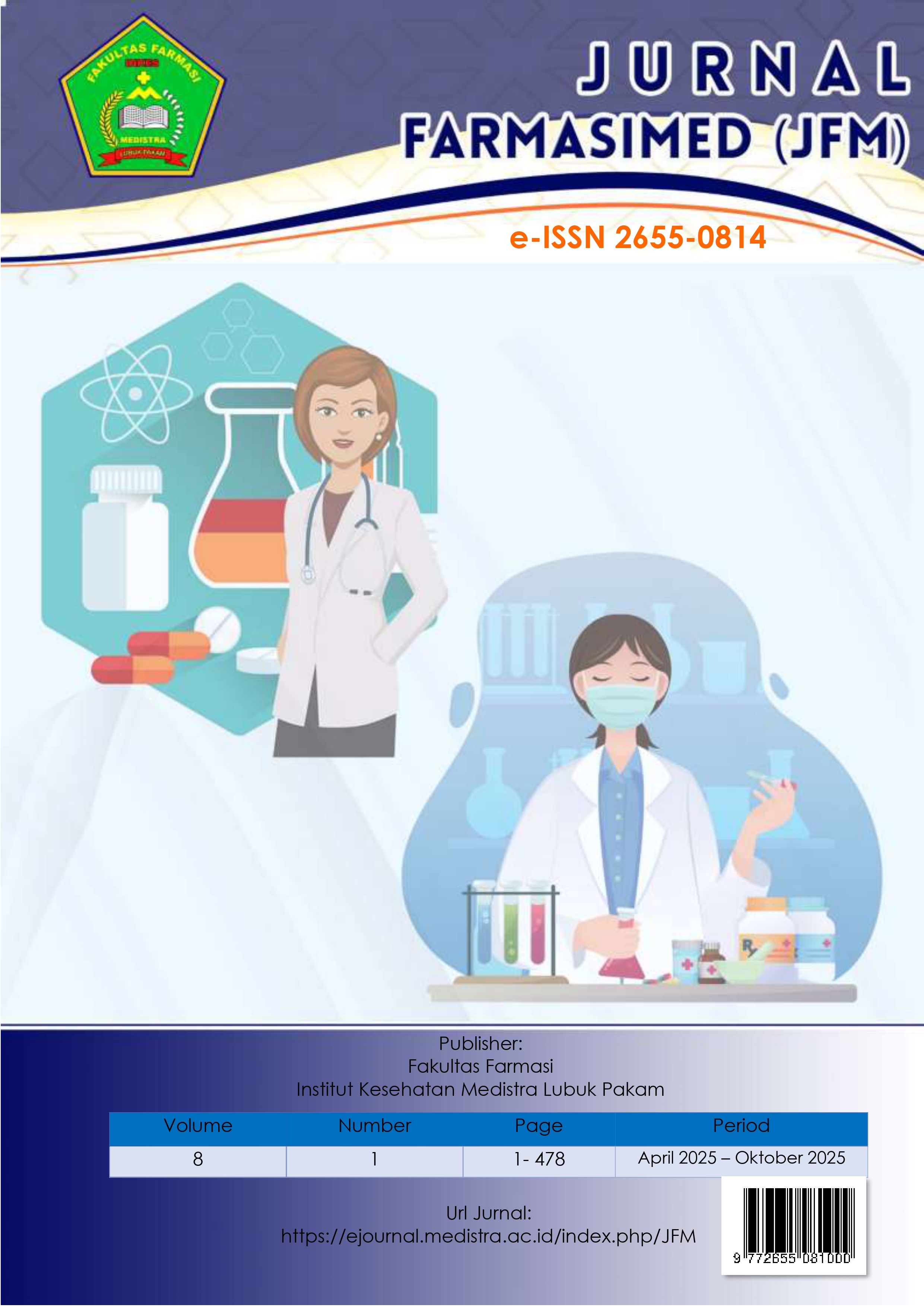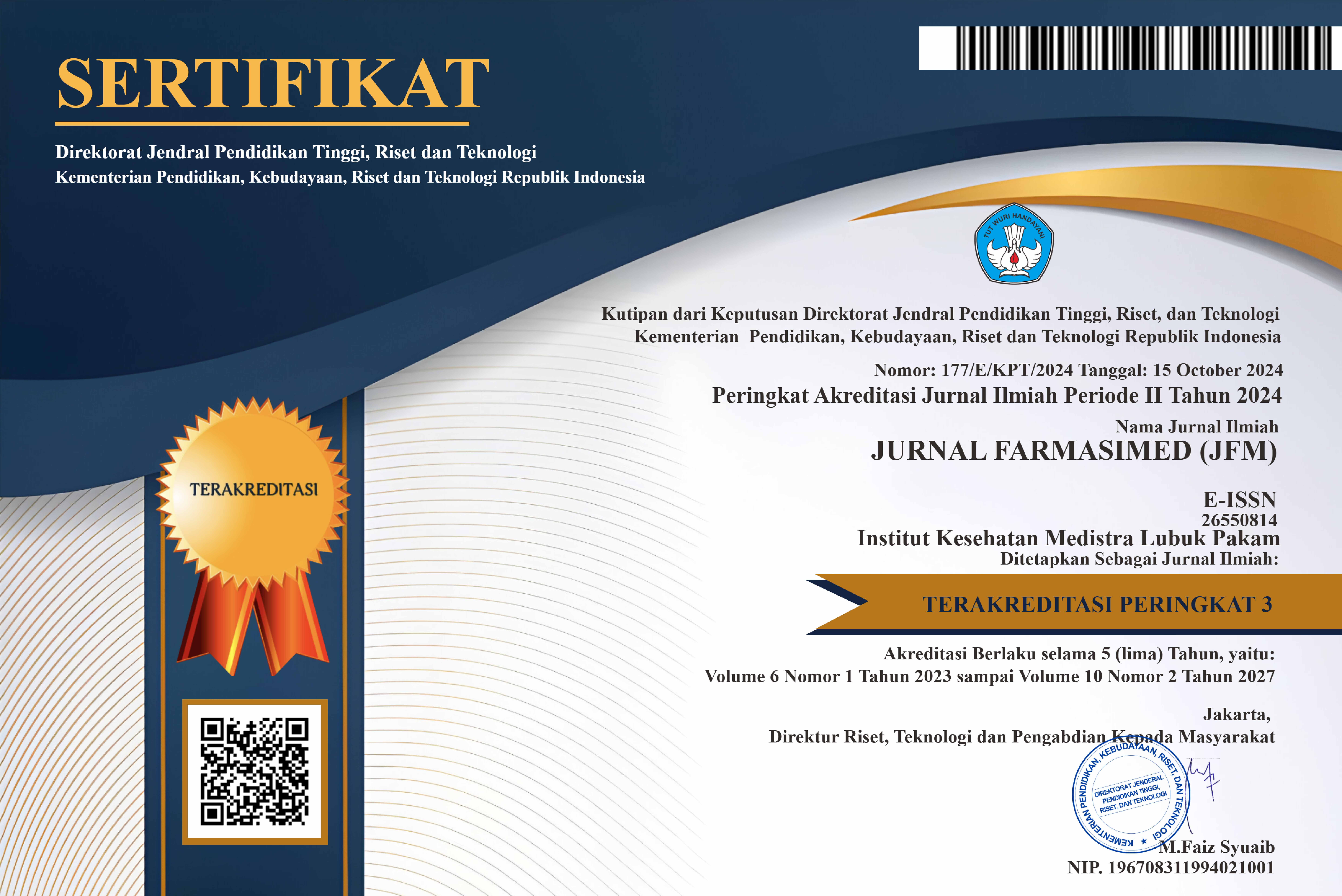Hepatoprotective Activity of the Combined Leaf Extracts of Syzygium Polyanthum and Moringa oleifera Against AntituberculosisDrug-Induced Hepatotoxicity in Rats
DOI:
https://doi.org/10.35451/rezxt096Keywords:
Hepatoprotective, Syzygium polyanthum, Moringa Oleifera, OATAbstract
Oral antituberculosis drugs (OAT) used repeatedly can negatively impact the liver. Natural compounds with high antioxidant potential could be used as hepatoprotective agents. This study aims to determine the hepatoprotective activity of the combination ethanolic leaf extract of Syzygium polyanthum (SPEE) and Moringa oleifera (MOEE) in rats administered with OAT. The hepatoprotective activity of the combination of SPE and MOE was determined by calculating the SGOT and SGPT levels of rats administered rifampicin (RMP), pyrazinamide (PZA), and isoniazid (INH) for 14 days. An experimental study using eight groups: standard control (CMCM-Na), negative control treatment with OAT (RMP 100 mg/kg BW; PZA: 252 mg/kg BW INH 50 mg/kg BW), positive control (OAT + Curcumin 100 mg/kg BW), OAT+SPEE 150 mg/kg BW group, OAT+MOEE 400 mg/kg BW group, and 3 group OAT + combination SPEE and MOEE (25%: 75%; 50%:50%; 75%:25%). SGPT & SGOT levels were determined using spectrophotometry with analytical methods using specific SGPT & SGOT reagent kits at 340 nm. After 14 days of OAT administration, SGOT levels increased by 1.3-fold, and SGPT levels increased by 1.8-fold compared to baseline levels. This considerable increase is still considered mild hepatotoxicity. The combination of SPEE: MOEE (25%:75%) was most effective in decreasing SGOT levels by 23.5%, or 1.3-fold, whereas the combination treatment of SPEE: MOEE (75%; 25%) was most effective in reducing SGPT levels by 51.56%, or 2-fold. The ratio value of the decrease in SGOT and SGPT levels from single SPEE and MOEE and the combination of both (p>0.05). The combination treatment of SPEE and MOEE in rats administered OAT showed an additive effect and could evolve as a hepatoprotective substance.
Downloads
References
[1] World Health Organization, “Global Tuberculosis report 2022,” electronic report isbN 978-92-4-006172-9, 2022.
[2] R. Kemenkes, Tuberculosis Report In Indonesia 2022. JAKARTA,INDONESIA, 2022.
[3] I. G. Juliarta and N. K. Mulyantari, “Gambaran Hepatotoksitas (ALT/AST) Penggunaan Obat Anti Tuberkulosis Lini Pertama Dalam Pengobatan Pasien Tuberkulosis Paru Rawat Inap Di RSUP Sanglah Denpasar Tahun 2014,” vol. 7, 2018.
[4] T. Ardiani and R. N. Azmi, “Identifikasi Kejadian Hepatotoksik pada Pasien Tuberkulosis dengan Penggunaan Obat Anti Tuberkulosis di Rumah Sakit Umum Daerah Abdul Wahab Sjahranie,” vol. 3, no. 1, 2021.
[5] S. Soedarsono and A. R. W. Riadi, “Tuberculosis Drug-Induced Liver Injury,” JR, vol. 6, no. 2, p. 49, May 2020, doi: 10.20473/jr.v6-I.2.2020.49-54.
[6] Hariyento Halim, Ermi Girsang, and Ali Napiah Nasution, “Hepatoprotective Effectiveness Test of Salam Leaf Extract in Anthracyclin-Induced Rats,” IJHP, vol. 2, no. 1, pp. 36–52, Feb. 2022, doi: 10.51601/ijhp.v2i1.11.
[7] N. A. Nurulita, E. Sundhani, I. Amalia, F. Rahmawati, and N. N. D. Utami, “Uji Aktivitas Antioksidan dan Anti Aging Body Butter dengan Bahan Aktif Ekstrak Daun Kelor,” JURNAL ILMU KEFARMASIAN INDONESIA, vol. 17, no. 1, Art. no. 1, Apr. 2019, doi: 10.35814/jifi.v17i1.543.
[8] T. L. C. Oldoni et al., “Bioguided extraction of phenolic compounds and UHPLC-ESI-Q-TOF-MS/MS characterization of extracts of Moringa oleifera leaves collected in Brazil,” Food Research International, vol. 125, p. 108647, Nov. 2019, doi: 10.1016/j.foodres.2019.108647.
[9] J. Adnan, Y. Y. Djabir, M. Mufidah, and S. Sartini, “Pengaruh Pemberian Ekstrak Air Rosella (Hibiscus sabdariffa L) Terenkapulasi Maltodextrin Terhadap Peroksidasi Lipid Hati Dan Ginjal Tikus Wistar Jantan Yang Diinduksi Isoniazid-Rifampisin,” MFF, vol. 22, no. 1, pp. 31–34, Jul. 2018, doi: 10.20956/mff.v22i1.5695.
[10] M. M Thuawaini, M. B. G. Al-Farhaan, and K. F Abbas, “Hepatoprotective And Nephroprotective Effects Of the Aqueous Extract Of Turmeric (Curcuma longa) In Rifampicin And Isoniazid-Inducted Hepatotoxicity And Nephrotoxicity In Rats,” Asian J Pharm Clin Res, pp. 293–298, Feb. 2019, doi: 10.22159/ajpcr.2019.v12i3.30419.
[11] W. Lin and J. Guo Jiang, “Protective effects of plant-derived flavonoids on hepatic injury,” ResearchGate, Aug. 2025, doi: 10.1016/j.jff.2018.03.015.
[12] A. Kuttiappan et al., “Hepatoprotective effect of flavonoid rich fraction of Sesbania grandiflora: Results of In vivo, in vitro, and molecular docking studies,” Journal of Ayurveda and Integrative Medicine, vol. 15, no. 5, p. 101036, Sep. 2024, doi: 10.1016/j.jaim.2024.101036.
[13] Y.-B. Xu, G.-L. Chen, and M.-Q. Guo, “Antioxidant and Anti-Inflammatory Activities of the Crude Extracts of Moringa oleifera from Kenya and Their Correlations with Flavonoids,” Antioxidants, vol. 8, no. 8, p. 296, Aug. 2019, doi: 10.3390/antiox8080296.
[14] Y. Dong, Y. Zhang, Y. Feng, and W. An, “The protective roles of augmenter of liver regeneration in hepatocytes in the non-alcoholic fatty liver disease,” Front. Pharmacol., vol. 13, Oct. 2022, doi: 10.3389/fphar.2022.928606.
[15] I. S. Dewi, T. Saptawati, and F. A. Rachma, “Skrining Fitokimia Ekstrak Etanol Kulit dan Biji Terong Belanda (Solanum betaceum Cav.),” vol. 4, 2021.
[16] K. Pebriana, M. Idris, and Rahmadina, “Organoleptic Test of Salam Leaves (Syzygium polyanthum) as an Herbal Drink with the Addition of Moringa Leaves (Moringa oleifera L.),” JURNAL BIOS LOGOS, vol. 14, no. 1, pp. 105–111, Mar. 2024, doi: 10.35799/jbl.v14i1.54689.
[17] Y. Liao, F. Lv, T. Quan, C. Wang, and J. Li, “Flavonoids in natural products for the therapy of liver diseases: progress and future opportunities,” Front. Pharmacol., vol. 15, Oct. 2024, doi: 10.3389/fphar.2024.1485065.
[18] Gajender, A. Mazumder, A. Sharma, and Md. A. K. Azad, “A Comprehensive Review of the Pharmacological Importance of Dietary Flavonoids as Hepatoprotective Agents,” Evid Based Complement Alternat Med, vol. 2023, p. 4139117, Apr. 2023, doi: 10.1155/2023/4139117.
[19] M. Singh et al., “Protective effect of curcumin, silymarin and N-acetylcysteine on antitubercular drug-induced hepatotoxicity assessed in an in vitro model,” Human and Experimental Toxicology, vol. 31, no. 8, Art. no. 8, Jan. 2012, doi: 10.1177/0960327111433901.
[20] L. Zhong, J. Tian, Q. Hu, L. Zhao, Q. Zhan, and M. Zhao, “Mitochondria-targeted nanoparticles based on glycated oat protein for enhanced curcumin bioavailability and antioxidant activity,” Food Bioscience, vol. 60, p. 104386, Aug. 2024, doi: 10.1016/j.fbio.2024.104386.
[21] V. Ruiz de Porras, M. Figols, A. Font, and E. Pardina, “Curcumin as a hepatoprotective agent against chemotherapy-induced liver injury,” Life Sciences, vol. 332, p. 122119, Nov. 2023, doi: 10.1016/j.lfs.2023.122119.
[22] N. M. D. Sandhiutami, R. S. Dewi, S. Khairani, and R. N. A. Putri, “Enhancement of curcumin level and hepatoprotective effect in rats through antioxidant activity following modification into nanosized particles,” Vet World, vol. 15, no. 9, pp. 2323–2332, Sep. 2022, doi: 10.14202/vetworld.2022.2323-2332.
[23] T. Kabir and R. Hossain, “Hepatoprotective Activity of Ethanolic Extract from the Stem Bark ff Synedrella Nodiflora on Carbon Tetrachloride Induced Hepatotoxicity in Swiss Albino Rats,” International Journal of Pharmacognosy, vol. 1, 2024.
[24] N. Rosyidah, E. Widyastuti, A. A. Rahman, N. S. Handayani, and Belgis, “Correlation Between SGOT and SGPT Levels With Positive HBsAg Levels,” Journal of Vocational Health Studies, vol. 8, no. 1, Art. no. 1, Jul. 2024, doi: 10.20473/jvhs.V8.I1.2024.1-6.
[25] L. Nuyttens, J. Vandewalle, and C. Libert, “Sepsis-induced changes in pyruvate metabolism: insights and potential therapeutic approaches,” EMBO Mol Med, vol. 16, no. 11, pp. 2678–2698, Oct. 2024, doi: 10.1038/s44321-024-00155-6.
[26] A. Sayamber, “A study of changes in SGPT and SGOT over time the patients of drug induced hepatitis taking antitubercular drugs,” MedPulse International Journal of Medicine, vol. 3, no. 2, 2017.
Downloads
Published
Issue
Section
License
Copyright (c) 2025 ELZA SUNDHANI, Galar Sigit Prasuma, Reninta Firda Ramadhani

This work is licensed under a Creative Commons Attribution-NoDerivatives 4.0 International License.
Copyright in each article is the property of the Author.

























